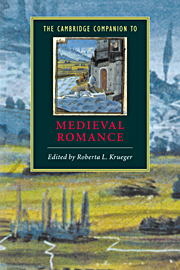Book contents
- Frontmatter
- Introduction
- Part 1 The origins, forms, and contexts of medieval romance
- Part 2 European romance and medieval society
- Part 3 European transformations
- 10 The evolution and legacy of French prose romance
- 11 Medieval German romance
- 12 Chivalry and medieval Italian romance
- 13 Gawain and popular chivalric romance in Britain
- 14 Middle English romance
- 15 Romance at the crossroads
- Editions and translations
- Index
- Series list
14 - Middle English romance
family, marriage, intimacy
from Part 3 - European transformations
Published online by Cambridge University Press: 28 May 2006
- Frontmatter
- Introduction
- Part 1 The origins, forms, and contexts of medieval romance
- Part 2 European romance and medieval society
- Part 3 European transformations
- 10 The evolution and legacy of French prose romance
- 11 Medieval German romance
- 12 Chivalry and medieval Italian romance
- 13 Gawain and popular chivalric romance in Britain
- 14 Middle English romance
- 15 Romance at the crossroads
- Editions and translations
- Index
- Series list
Summary
The purpose of this essay is to look at Middle English romances from the perspective of private life. It sets them in the context of late medieval patterns of family and marriage, and presents them as part of a literate but unlearned lay culture centered on the home, where many of them seem to belong. It does not provide a survey, because that has already been done several times, but rather, by looking at around half-a-dozen, suggests a new approach.
The late medieval family can be thought of in two ways. First, as a group of people living together in the “nuclear family household” formation consisting of wife, husband and dependent children, whose home would also include servants and apprentices. The nuclear family, then as now, is always in process, because it comes into being with a marriage and is reshaped by the children’s departure. Another way of thinking about the family, though, is as a lineage that is the route for the transmission of property and privilege. In late medieval England wealth and ownership of land provided access to social prestige and political power; the family, especially the male line, was the means whereby these were passed on from one generation to the next. From the point of view of the lineage the son’s role was crucial because his marriage ensured its continuity; the marriage of the daughter who inherited took the property to another family. All this is the stuff of Middle English romance; many of its plots are derived from the crises and hiatuses of the nuclear family and the lineage, as I shall show.
- Type
- Chapter
- Information
- The Cambridge Companion to Medieval Romance , pp. 235 - 252Publisher: Cambridge University PressPrint publication year: 2000
- 4
- Cited by



